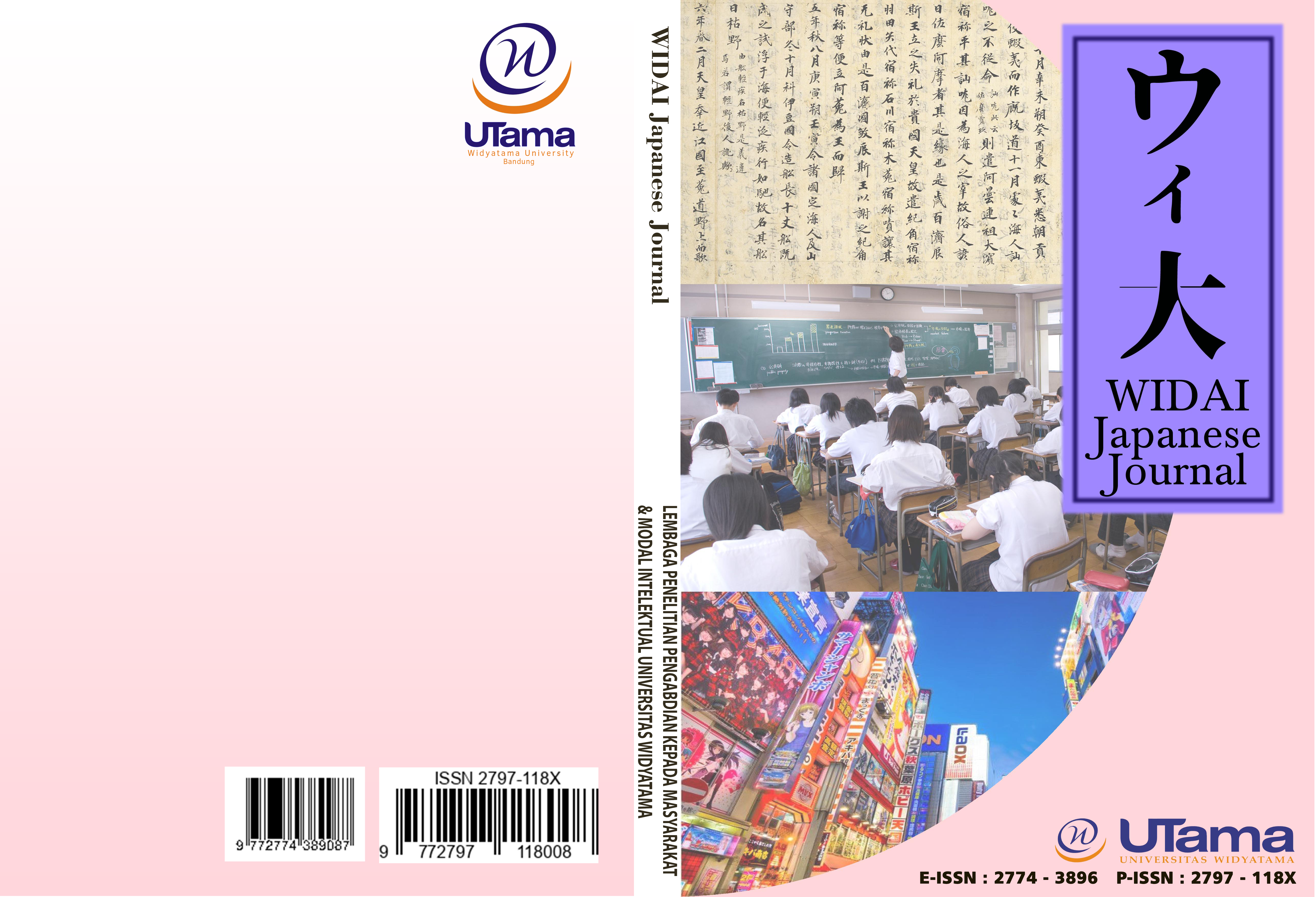'ARIGATOU' PHRASE IN JAPANESE DAILY LIFE
DOI:
https://doi.org/10.33197/widai.vol1.iss2.2021.674Keywords:
Arigatou, On, arigatou definition, gratitude, harmony keeperAbstract
In daily social life, humans cannot be separated with interaction with nature, and it includes giving and receiving. In Japanese society, a gift is always depicted as On or debt which must be repaid in later time. One way to pay On is through the phrase arigatou. This research objective is to describe Arigatou phrase based on the meaning and forms of expression inside Japanese society daily life. Methods used in this research is Descriptive Methods which utilizes symbolic interaction theory to analyze the data. Result found is that arigatou was originally addressed to God and gradually used in daily life. From meaning perspective arigatou described as gratitude and social harmony keeper and was addressed to the Emperor as expression of loyalty towards the country with full consent on abiding the law. Meanwhile the phrase arigatou in family is meant to express obedience towards every decision made by the family to maintain honor within said family. Arigatou phrase towards nature is to include them in every element of life. Found conclusion is that Arigatou phrase included Up-Down essence, which means the relation between Kami (God) (Up) and Humans (Down), described arigatou in both form of phrase and meaning.
Downloads
References
Benedict, Ruth. 1982. Pedang Samurai danBungaSeruni (Pola-PolaKebudayaanJepang). Jakarta: SinarHarapan.
Emmons, Robert A. 2016. ???????????? The Little Book Of Gratitude. Japan: President Inc. Dalam website https://books.google.co.id/books?id=wAQ3DgAAQBAJ&dq=?????????&hl=id&source=gbs_navlinks_s diakses tanggal 23 Januari 2017.
Fujimaki, Yukio. 2013. NazeAnoHitoWaItsumoTasuketeKureru No Ka. Japan: PHP Business Shinsho. dalam website: https://books.google.co.id/books?isbn=4569815030
Hasibuan, Rahmadia.2010. AnalisisPerilakuOndanGiridalam Novel Samurai Kazegatanakarya Ichirou Yukiyama. Skripsi. Medan: Universitas Sumatera Utara.
Itou, Tadahara. 2014. Kansahawo KanjiruKeiken to KanshaSareruKeikenniOkeruKanjou ???????????????????
??? dalam website http://glimre.glim.gakushuin.ac.jp/bitstream/10959/3810/1/kenkyunenpo_61_99_117.pdfdiaksestan
ggal 14 April 2017.
Kamus Besar Bahasa Indonesia (edisi ketiga). Pusat Bahasa Depdiknas. 2001. Jakarta: Balai Pustaka.
Kurita, Isamu.1993. Nihon Bunka no Keyword. Tokyo: Shoudensha
Nami, Yoshioka. 2013. Arigatou De KisekiGaOkoru.PHP Kenkyujo.dalam website: https://books.google.ae/books?id=GONUBQAAQBAJ&pg=PT45&dq=?????????????&hl=en&sa=X&ved=0ahUKEwjH7beC6ePaAhWMabwKHe5YCSoQ6AEIJTAA#v=onepage
&q=?????????????&f=false diakses pada tanggal 2 Oktober 2017.
Nihon Koku Go Jiten. 1995. Japan: Dainippon InsatsuKabushikigaisha.
Saifudin, Akhmad. 2010. Analisis Pragmatik Variasi Kesantunan Tindak Tutur Terima Kasih Bahasa Jepang dalam Film Beautiful karya Kitagawa Eriko dalam website http://www.dinus.ac.id/wbsc/assets/dokumen/majalah/Analisis_Pragmatik_Variasi_Kesant
unan_Tindak_Tutur_Terima_Kasih_Bahasa_Jepang_dalam_Film_Beautiful_Life_Karya_Kitagawa_Eriko.pdfdiaksestanggal 23 April 2017.
Saragih, Kristin Juliana. 2011. GimudanGiridalamKomik Say Hello to Black Jack edisi 1-4 karya Sato. Skripsi. Medan: Universitas Sumatera Utara.
Takashi, Hosoka. 2006. PuchiTaijinSutoresuni Sayonara Suru Hon. Japan: PHP Kenkyujo.
Weston Mail Magazine. 2007. Vol.002 dalam website http://www.weston.co.jp/merumaga/pdf/002_MailMagazine.pdfdiaksespadatanggal 19 Mei 2017
Yokota, Kazunori. 2009. KokoroToKarada No Joukahou. PHP Kenkyujou, Dalam Website file:///D:/??????????????????????%20-%20-????Google%20Buku.htm, diaksestanggal 27 Juni 2017.
Yosei, Masahara. 2003. Arigatou Nihon Up down Kouzou. Osaka: Transpace.
http://eigodesoka.blogspot.co.id/2017/09/the-miraculous-words-thank-you.html
http://blog.goo.ne.jp/chorinkai/e/c00add7d8c5d88d89b02d763770833cf,
http://www.sankei.com/life/news/171202/lif1712020036-n3.html












